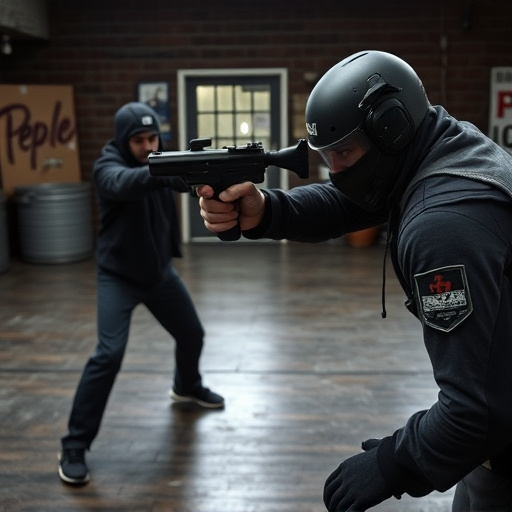Environmental factors like humidity, wind, and temperature impact pepper spray effectiveness in riot control. Understanding these conditions is key for optimal performance and minimizing health risks associated with its use. Law enforcement agencies explore alternative non-lethal methods, focusing on de-escalation strategies while considering future technologies to enhance crowd control tools.
In the realm of riot control, inflammatory spray, or pepper spray, is a ubiquitous tool employed by law enforcement worldwide. This article delves into the intricate details surrounding this non-lethal weapon, focusing on its composition and effectiveness, while exploring critical environmental factors such as temperature, humidity, and wind impact that affect its performance. We also examine health risks, safety measures for officers, and alternative strategies, including cutting-edge non-lethal options and future technologies in the ever-evolving field of public safety.
- Understanding Pepper Spray: Composition and Effectiveness
- Environmental Factors: Temperature, Humidity, and Wind Impact
- Health Risks and Safety Measures for Law Enforcement
- Alternative Strategies: Non-Lethal Options and Future Technologies
Understanding Pepper Spray: Composition and Effectiveness
Pepper spray, a common tool in riot control and crowd management, is a chemical agent designed to cause temporary disorientation and discomfort. Its primary active ingredient is capsaicin, derived from chili peppers. This compound irritates the eyes, nose, throat, and skin, leading to coughing, tears, and difficulty breathing. The effectiveness of pepper spray can be influenced by various environmental conditions. For instance, high humidity levels can reduce its potency as water molecules dilute the chemical’s concentration. Wind and air currents can also disperse the spray, impacting its accuracy and intensity. Temperature plays a role too; extreme cold or heat may cause the spray to solidify or evaporate faster than ideal, affecting its delivery system.
Understanding these environmental factors is crucial for proper pepper spray deployment. In optimal conditions, such as dry and cool air, the spray’s effects can last longer, providing more control. However, in humid or windy environments, law enforcement agencies need to adjust their tactics accordingly. Regular maintenance and proper storage of pepper spray equipment are essential to ensure its reliability under all conditions, making it a versatile tool for maintaining public order.
Environmental Factors: Temperature, Humidity, and Wind Impact
The effectiveness of inflammatory spray for riot control can be significantly influenced by environmental conditions, particularly environmental conditions affect pepper spray performance. Temperature plays a crucial role; extreme heat or cold can cause the chemical composition of the spray to deteriorate, reducing its potency. In high temperatures, the active ingredients may break down faster, while freezing conditions could lead to solidification of the spray, impacting its dispersion and impact.
Humidity is another critical factor. High humidity levels can affect the spray’s ability to evaporate quickly, potentially leading to a less effective inhalation irritant. Conversely, low humidity might cause the spray particles to dry out and become more potent. Wind conditions also matter; strong winds can disperse the spray too quickly, limiting its contact time with targets. Conversely, calm or light winds might allow the spray to linger in the air, increasing the risk of secondary exposure for bystanders or law enforcement personnel.
Health Risks and Safety Measures for Law Enforcement
Health risks and safety measures for law enforcement using inflammatory spray, such as pepper spray, are crucial considerations in riot control scenarios. While effective in de-escalating and controlling crowds, these agents can have significant health implications if not used appropriately. Pepper spray can cause respiratory irritation, coughing, and difficulty breathing, especially in individuals with pre-existing respiratory conditions or during high environmental temperatures and humidity levels. These environmental conditions affect pepper spray’s potency and duration, potentially exacerbating its effects.
To mitigate risks, law enforcement agencies must ensure adequate training for officers on safe application techniques and the recognition of adverse reactions. Proper ventilation and hydration are essential, particularly in enclosed spaces or during prolonged use. Wearing protective gear, such as eye protection and respirators, can further minimize exposure to pepper spray. Additionally, having immediate access to decontamination facilities and medical support is vital to promptly address any health issues arising from its use.
Alternative Strategies: Non-Lethal Options and Future Technologies
In addition to traditional pepper spray, law enforcement agencies are exploring alternative, non-lethal options to manage crowd control and riot situations. These strategies focus on de-escalation, disability, or disorientation techniques rather than direct physical harm or fatal force. For instance, non-lethal weapons like rubber bullets, flashbang grenades, and smoke canisters are designed to temporarily disrupt or disperse crowds while minimizing injuries.
Looking ahead, future technologies in riot control aim to enhance existing non-lethal options further. Developing formulations of pepper spray that consider environmental conditions, such as humidity and wind speed, could improve its effectiveness and reduce off-target effects. Additionally, advancements in noise and light-based deterrents, like high-intensity lasers and ultrasonic sounds, offer promising avenues for crowd control without resorting to chemical agents or physical force.
Pepper spray, while effective in riot control, is significantly influenced by environmental conditions such as temperature, humidity, and wind. These factors can impact its effectiveness, making it essential for law enforcement to consider these variables during deployment. Understanding the composition and health risks associated with pepper spray, along with exploring alternative non-lethal options, ensures a balanced approach to crowd control that prioritizes safety and public well-being. By considering both traditional and emerging technologies, law enforcement can navigate complex situations more effectively while mitigating potential harm.
